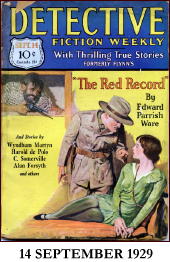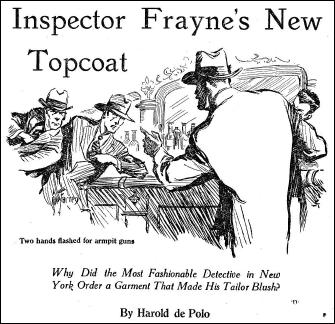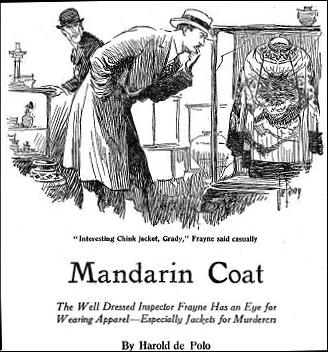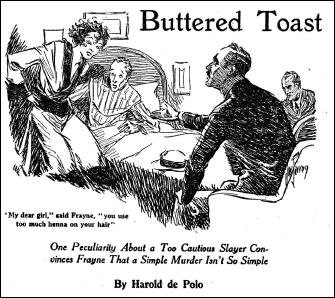Sat 18 Feb 2012
Characters from DFW #11: INSPECTOR FRAYNE — by Monte Herridge.
Posted by Steve under Bibliographies, Lists & Checklists , Characters , Columns , Pulp Fiction[6] Comments
DETECTIVE FICTION WEEKLY
by Monte Herridge
#11. INSPECTOR FRAYNE, by Harold de Polo.
Harold de Polo created a short-lived series about a dandy police inspector named Frayne. Frayne prides himself on being the best-dressed man in the police department and one of the best in the city.
His personal assistant is a red-haired detective named Don Haggerty, who was known in the department as Frayne’s right-hand man. He did many of the basic detective chores required in investigations, such as looking over the crime scene for any interesting signs or clues. He was also known as “a bulldog on the trail, too.†(The Small Glass Eye, DFW, 14 Sept 1929)

Haggerty was indispensable to Inspector Frayne in his cases. Frayne considered him a man-hunter in training, and his personal protégé. However, Frayne noted that Haggerty was “still young enough to have likes and dislikes. Inspector Frayne called them intolerances, stumbling blocks in the path of efficient police duty.†(The Small Glass Eye)
This view of Frayne gives a clue to his personality, showing that he believed that efficiency and unemotional attitudes were the key to better detective work. In the previously mentioned case he had an innocent person arrested for a murder so that the real murderer would believe he was free of suspicion.
Frayne often used psychological tricks to get suspects and witnesses to respond in the way he wished. Haggerty knew that the “manhunter never assumed an attitude, never made a gesture, never uttered a word, that didn’t mean something.†(La Linda Paloma) In this story Frayne “was simply getting his suspects more on edge.â€
One problem with some of the stories is that Frayne seems to operate as an intuitive detective, with not much in the way of clues to show his line of thinking. “La Linda Paloma†actually is much better than the usual stories in the series; he has definite clues and details how they affected his thinking.
In the earliest of the stories in the series, “The Small Glass Eye,†Frayne investigates a crime out of his jurisdiction at a lake in the Adirondacks. The cause of his investigating this murder illustrates a facet of Frayne’s personality. His one interest, aside from his clothes, was in investigating murders. It was a hobby with him, and “He could sniff it a mile off, a thousand miles off, … †After reading a couple of newspaper articles about the death of millionaire Gideon Whipple, Frayne was certain that it was not an accidental death but a purposeful murder.
One of Frayne’s regular habits was his reading of all the morning newspapers in New York, as well as many papers from other cities including some foreign ones. He was noted as a speed reader, which was an advantage considering how many newspapers he read. He also had “a reading knowledge of seven or eight languages.†(La Linda Paloma) His greatest trait was that he had a photographic memory for all of the newspaper pieces he read, and could recite lines and paragraphs going back years.
Frayne had seven telephones, some of them private and others for business. Six of his telephones were in his apartment in the East Fifties of New York City, and the seventh in his basement shooting gallery. One of his private lines was directly connected to Don Haggerty’s office at police headquarters. When he wanted to summon Haggerty, Frayne picked up the telephone and clicked his message by moving the receiver up and down. Haggerty responded similarly.
Frayne lived close to police headquarters, because as noted in the stories it took Haggerty only twelve minutes to make the trip to Frayne’s residence. Frayne’s multistory home is well suited for him. Special closets for his clothes, for example. The basement has a special shooting range so that Frayne can keep in practice with his specially made and altered blunt-nose automatic. He has one his topcoats specially altered so he can draw his gun faster.

Frayne also had several automobiles, all well powered. One is a roadster. Frayne does not have to worry about his expenses based upon his detective’s pay; he can afford to own all of these things because he “possessed a sufficiently substantial private fortune to enable him to do this,†(The Missing Clew).
Haggerty’s responsibilities change somewhat over the course of the series. He gradually was given more responsibility, and became the “buffer†for Frayne. In this position, Haggerty had to weed out the homicide cases for which Frayne was suited, and “to offer his chief only such problems as appeared to be impossible to unravel.†(Pelican Plot)
In other words, common murder cases of no difficulty were refused by Haggerty. Haggerty at this point spoke to Frayne over a special wire connection to Frayne’s apartment, using a number known only to him.
Other than Haggerty, there are only a couple of other recurring characters in the series. One is Grady, the coroner, who is also an expert on guns and a friend of Frayne’s. He “was one coroner who didn’t hanker to be a great detective.†(Mandarin Coat)

There is a detective named Mullins, who “was a slim stoop-shouldered man in a pepper-and-salt suit far from new. His eyes looked tired…†(Buttered Toast) Mullins has dreams of solving murders. He also is able to identify criminals based on witness descriptions. He knows a considerable amount about the local criminals and their habits and hangouts. Frayne relies on him to help in some of his cases.
In the story “Inspector Frayne’s New Topcoat†Frayne is after the gangsters who killed a homicide detective and “one of Frayne’s favored men.†In this story, too, Frayne has an innocent man arrested as a way to get at the guilty party. Seems to be one of his methods of operation.
“The Missing Clew†involves Frayne’s investigation of the murder of an eccentric rich man. Once more he intuits what really occurred, from the evidence of muddy dog footprints. A minor story in the series.
“Buttered Toast†is a much better story, as Frayne unravels the mystery of what seems to be a simple robbery and murder of a jewelry wholesaler. Frayne comes across many clues and uses them to deduce an unusual crime and the motives for it. In this story, Haggerty is noted as being an improving fingerprint expert.

“Mandarin Coat†is an interesting story of an investigation by Frayne of a poisoning case. The puzzle is how was the poison administered to the victim, and who could have done it. The method of poisoning is a clever one. The story could have been a bit longer, to explain how Frayne learned some of the facts he disclosed late in the story.
In “Pelican Plot†Frayne has to unravel the who and how of a murder case seemingly impossible. Mr. Kerfoot, a rich manufacturer, has a bronze figure of a pelican on his desk that is wired to follow certain instructions such as raising windows, opening a door, and pulling out chairs for guests. However, it turns out that someone has added an extra command for seemingly shooting a gun from a hidden place. Another case where Frayne seemingly intuits the solution with ease.
In “La Linda Palomaâ€, the next story in the series, Frayne has to find the murderer of a personal maid to a world famous dancer named La Linda Paloma. Any of a number of people nearby could have stabbed the woman, so Frayne has to find small clues that point the way.
The series as a whole is just an average detective series, with nothing particularly special about it. Harold de Polo had more success with his stories featuring hick country law enforcement officials. There were two series of these: Sheriff Ollie Bascomb, and another featuring Sheriff Whitcher Bemis. Both had elements of humor in them. Another outdoor series featuring Chan Buzzell was a bit more serious.
The Inspector Frayne series, by Harold de Polo:
In Detective Fiction Weekly:
The Small Glass Eye September 14, 1929
Inspector Frayne’s New Topcoat November 2, 1929
The Missing Clew December 21, 1929
Buttered Toast January 25, 1930
Murder in the Tower March 1, 1930
Mandarin Coat March 8, 1930
Pelican Plot April 5, 1930
The Flying Corpse July 12, 1930
The Little White Powder July 26, 1930
La Linda Paloma December 27, 1930
Peter Wenda, Beads January 24, 1931
In Complete Detective Novel Magazine:
Night Club Riddle May, 1931
In The Underworld Magazine:
Inspector Frayne Returns July, 1933
Previously in this series:
1. SHAMUS MAGUIRE, by Stanley Day.
2. HAPPY McGONIGLE, by Paul Allenby.
3. ARTY BEELE, by Ruth & Alexander Wilson.
4. COLIN HAIG, by H. Bedford-Jones.
5. SECRET AGENT GEORGE DEVRITE, by Tom Curry.
6. BATTLE McKIM, by Edward Parrish Ware.
7. TUG NORTON by Edward Parrish Ware.
8. CANDID JONES by Richard Sale.
9. THE PATENT LEATHER KID, by Erle Stanley Gardner.
10. OSCAR VAN DUYVEN & PIERRE LEMASSE, by Robert Brennan.
February 18th, 2012 at 10:18 pm
This is a great series of articles.
The Inspector Frayne stories sound like a fun series. One wishes they were available to read someplace.
The mix of impossible crimes and howdunits is also intriguing.
February 19th, 2012 at 12:26 am
Even though Monte describes the stories as only average, he makes them sound interesting. The setting and various mannerisms of Frayne may be cliches by now (and maybe they were then) I agree with you, Mike, that this might be a series worth collecting and reprinting.
As I told Monte when he sent me this article on Inspector Frayne, I don’t have as many DFW’s from the 1920s as I’d like. His columns make me wish I’d been more persistent in collecting them when they were a lot easier to find than they are now.
February 19th, 2012 at 7:58 pm
I’ve found one novelette by Harold de Polo online, not in this series, but as a sample of his writing you can check it out here:
http://www.unz.org/Pub/ArgosyWeekly-1935dec28-00024?View=PDF&apages=0026
It’s “Blinkers in Bermuda,” a horse racing story scanned from ARGOSY from December 28, 1935.
And from this Wikipedia page, it seems that de Polo was a good friend of playwright Eugene O’Neill:
http://en.wikipedia.org/wiki/Atlantic_House
February 19th, 2012 at 10:08 pm
One of De Polo’s other series is about Game Warden Chan Buzzell, who seems to spend most of his time chasing murderers. I recently wrote an article only about the DFW appearances of this character, because I didn’t have any of his non-DFW stories in the series that appeared later. However, I just acquired an issue of SPEED DETECTIVE with a Chan Buzzell story, which I hope to scan later and place on pulpgen.com.
February 19th, 2012 at 11:08 pm
Monte
Make that http://www.pulpgen.com and maybe we can divert some readers of old pulp stories over that way.
Thinking of Chan Buzzell as a really unusual name, it reminded me that I meant to ask you, was Inspector Frayne ever given a first name?
February 20th, 2012 at 12:00 am
I never saw Inspector Frayne referred to by first name in any of the stories. I would guess he was too formal or had a too large ego to let anyone call him by his first name.